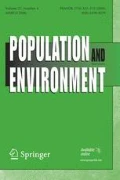Abstract
The relationship between intentions and behavior is basic to micro-level migration decision research. This study, set in the rural Philippine province of Ilocos Norte, provides evidence on personal and structural background factors and value-expectancy perceptions of place utility that predict migration intentions and behavior. Separate analyses are conducted for general intentions to move and for destination-specific migration intentions, the latter pertaining to both internal migration (Manila) and international migration (Hawaii). Logistic regression analyses applied to the data from a 1980–82 longitudinal survey show that the empirical models are highly efficient in explaining migration intentions but less efficient in explaining actual migration behavior in this Third World setting. Important explanatory variables for both intentions and behavior include family pressure to move or stay, family auspices at alternative destinations, money to move, prior migration experience, and the life cycle stage (marital status and age). However, the determinants of internal and international migration behavior are not the same. The data only partially support the Ajzen and Fishbein (1980) position that intentions are the dominant determinant of behavior. Personal and structural background factors are shown to exert independent direct effects on migration behavior.
Similar content being viewed by others
References
Abad, R., & Cariño, B. V. (1981).Micro-level determinants of migration intentions in the Ilocos: A preliminary analysis. Quezon City: Institute of Philippine Culture, Ateneo de Manila University.
Ajzen, I., & Fishbein, M. (1980).Understanding attitudes and predicting social behavior. Englewood Cliffs, NJ: Prentice-Hall.
Bach, R. L., & Smith, J. (1977). Community satisfaction, expectations of moving and migration.Demography 14 147–167.
Banerjee, B., (1981). Rural-urban migration and family ties: An analysis of family considerations in migration behavior in India.Oxford Bulletin of Economics and Statistics 43 321–345.
Brown, L. A., & Sanders, R. L. (1981). Toward a development paradigm of migration with particular reference to Third World settings. In G. F. De Jong & R. W. Gardner (Eds.),Migration decision making: Multidisciplinary approaches to microlevel studies in developed and developing countries (pp. 149–185). New York: Pergamon Press.
Caces, F., Arnold, F., Fawcett, J. T., & Gardner, R. W. (1985). Shadow households and competing auspices: Migration behavior in the Philippines.Journal of Development Economics 17 5–25.
Crawford, T. (1973). Beliefs about birth control: A consistency theory analysis.Representative Research in Social Psychology 4 53–65.
De Jong, G. F., & Fawcett, J. T. (1981). Motivation for migration: An assessment and a value-expectancy research model. In G. F. De Jong & R. W. Gardner (Eds.),Migration decision making: Multidisciplinary approaches to microlevel studies in developed and developing countries (pp. 13–58). New York: Pergamon Press.
De Jong, G. F., & Gardner, R. W. (Eds.), (1981).Migration decision making: Multidisciplinary approaches to microlevel studies in developed and developing countries. New York: Pergamon Press.
De Jong, G. F., Abad, R. G., Arnold, F., Cariño, B. V., Fawcett, J. T., & Gardner, R. W. (1983). International and internal migration decision making: A value-expectancy based analytical framework of intentions to move from a rural Philippine province.International Migration Review 17 470–484.
Fienberg, S. E. (1981).The analysis of cross-classified categorical data. Cambridge, MA: MIT Press.
Fishbein, M., & Ajzen, I. (1975).Belief, attitude, intention, and behavior: An introduction to theory and research. Reading, MA: Addison-Wesley Publishing Co.
Forbes, D. (1981). Mobility and uneven development in Indonesia: A critique of explanations of migration and circular migration. In G. W. Jones & H. V. Richter (Eds.),Population mobility and development: Southeast Asia and the Pacific. Development Studies Center Monograph No. 27 (pp. 51–70). Canberra: Australian National University.
Harbison, S. F. (1981). Family structure and family strategy in migration decision making. In G. F. De Jong & R. W. Gardner (Eds.),Migration decision making: Multidisciptinary approaches to microlevel studies in developed and developing countries (pp. 225–251). New York: Pergamon Press.
Knoke, D., & Burke, P. J. (1982).Log-linear models. Beverly Hills: Sage Publications.
Liska, A. E. (1984). A critical examination of the causal structure of the Fishbein/Ajzen attitude-behavior model.Social Psychology Quarterly 47 61–74.
McHugh, K. E. (1983). Incorporating constraints into an attitude-based model of migration intentions. Paper presented at the Population Association of America annual meeting, April 14–16, Pittsburgh, PA.
National Census and Statistics Office (NCS) (1980).Census of Population. Vol. 1, Manila: Bureau of Census.
Newman, S. J., & Duncan, G. J. (1979). Residential problems, dissatisfaction, and mobility.Journal of the American Planning Association 45 154–166.
Sell, R. R., & De Jong, G. F. (1983). Deciding whether to move: Mobility, wishful thinking and adjustment.Sociology and Social Research 67 146–165.
Simon, H. A. (1980). The behavioral and social sciences.Science 209 72–78.
Smith, P. C. (1981). Population pressure and social response on the Ilocos Coast in the Philippines. Working paper No. 2, East-West Population Institute, Honolulu, HI.
Speare, A. (1974). Residential satisfaction as an intervening variable in residential mobility.Demography 11 173–188.
Speare, A., Kobrin, F., & Kingkade, W. (1982). The influence of socio-economic bonds and satisfaction of interstate migration.Social Forces 61 551–571.
Thadani, V. N. (1982).Social relations and geographic mobility: Male and female migration in Kenya. New York: The Population Council. Center for Policy Studies, working paper No. 85.
Author information
Authors and Affiliations
Rights and permissions
About this article
Cite this article
De Jong, G.F., Root, B.D., Gardner, R.W. et al. Migration intentions and behavior: Decision making in a rural Philippine province. Popul Environ 8, 41–62 (1985). https://doi.org/10.1007/BF01263016
Issue Date:
DOI: https://doi.org/10.1007/BF01263016




